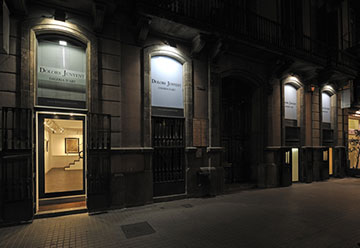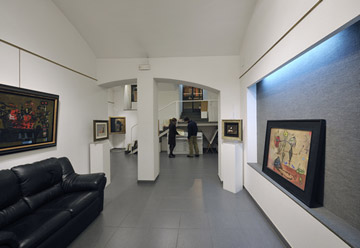- Amat, Frederic
- Amat, Gabriel
- Arranz Bravo
- Arroyo
- Barbara
- Barcelo
- Bartolozzi
- Bea
- Becquer
- Benet
- Bird
- Bores
- Brinkmann
- Brossa
- Cardenas
- Carral
- Casas
- Castillo
- Chancho
- Clave
- Corbero
- Corneille
- Croft
- Cuixart
- Domingo
- Fabres
- Farreras
- Feito
- Fenosa
- Forteza
- Genovart
- Gimeno
- Gonzalez
- Gonzalo
- Graner
- Granyer
- Grau
- Grau Sala
- Gudiol
- Guinovart
- Hernandez Mompo
- Hernandez Pijuan
- Jorn, Asger
- Junyent, Oleguer
- Lam
- Llena
- Lloveras
- Lopez Ramon
- Marin
- Marsans
- Marti Alsina
- Matilla
- Meifren
- Menchu Gal
- Meseguer
- Mir
- Mira
- Miro
- Moore
- Moragas
- Munoz
- Noland
- Olive
- Palazuelo
- Palencia
- Pazos
- Perejaume
- Perez Villalta
- Picasso
- Plasencia
- Plensa
- Ponç
- Puig
- Rafols Casamada
- Ramis
- Rasero
- Rebull
- Riera i Arago
- Rivera
- Roca Sastre
- Roig Soler
- Rossell
- Rueda
- Saura
- Serra
- Sicilia
- Solano
- Subirachs
- Sunyer
- Tamayo
- Tapies
- Tharrats
- Togores
- Torner
- Torres Garcia
- Ubeda
- Ucles
- Valdes
- Valls
- Vedova
- Viladecans
- Vilagrasa
- Zao Wou-ki
Artists +
Hours
Vazquez Diaz
BIOGRAPHY OF DANIEL VÁZQUEZ DÍAZ:
Daniel Vázquez Díaz was born in Nerva (Huelva) in 1882, into an affluent family. From a young age, he showed an interest in drawing, a passion supported by his mother. However, his father wanted him to continue in the textile trade. He began his artistic education as a self-taught artist.
In 1903, he went to Madrid to study at the Academy of San Fernando, but when he couldn’t enroll, he visited the Prado Museum to observe the works of the great masters and make copies. In 1906, he settled in Paris, where he encountered the works of the Impressionists, Post-Impressionists, Nabis, and Symbolists. Additionally, he discovered Cubism, which became a constant reference in his work. In 1907 and 1909, he exhibited works at the Salon des Indépendants.
His first solo exhibition was in 1910 at the Chevalier Gallery. He got married during this period and collaborated with the magazine "L’Espagne." In 1912, he published portraits in the magazine "Mundial," edited by Ruben Darío. His first exhibition in London took place in 1913 at the Grafton Gallery. He worked with sculptor Antonio Bourdelle, who influenced the sculptural profiles in his paintings.
During World War I in 1914, Vázquez Díaz did not leave France. In 1918, he returned to Spain with his first exhibition in Madrid at the Salon Lacoste. He established his own workshop where he created and taught.
He exhibited at the Royal Academy in London, had his first exhibition in Bilbao, Barcelona, Portugal, and in 1926, at the International Exhibition of Venice, and in 1927 in Buenos Aires, Argentina.
Vázquez Díaz is one of the most representative figures in the Spanish artistic scene of the first half of the 20th century. He was highly regarded as a portraitist, considered the best portraitist of the time. His notable portraits include prominent artists and intellectuals of the 20th century such as Pío and Ricardo Baroja (1925), the Solana brothers (1930), Miguel de Unamuno, Ortega y Gasset, Ramón Pérez de Ayala, César González-Ruano, Eugenio d’Ors, Gregorio Marañón, Margarita Xirgu, Rubén Darío, Antonio Machado, Juan Ramón Jiménez, Federico García Lorca, Juan de la Cierva, Ignacio Sánchez Mejías, Picasso, among others.
His landscape paintings are also noteworthy. His palette is cool and clear in these works. The Basque geography, especially Fuenterrabía, captivated the artist, who spent many summers painting along the Bidasoa River. Vázquez Díaz called these landscapes "Instantes." Some notable examples include the numerous landscapes of Fuenterrabía and works like "Muros blancos en día gris." He also created a series dedicated to La Pedriza. His prominent landscape paintings include "Piedras junto al arroyo," "Piedra y agua," "La Pedriza mojada," and "Silencio."
In his career, there are also the frescoes he created for the monastery of La Rábida (1930), depicting the Discovery of America. One of his most emblematic works is perhaps "Las cuadrillas de Frascuelo, Lagartijo y Mazzantini" (1936), owned by the Reina Sofía Museum.
Vázquez Díaz passed away in Madrid in 1969.




